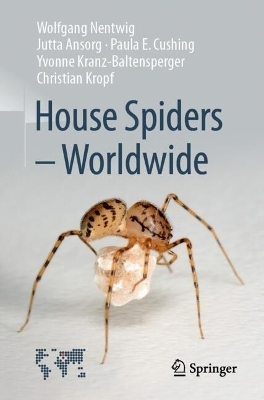
House Spiders - Worldwide
Springer International Publishing (Verlag)
978-3-031-70447-5 (ISBN)
- Noch nicht erschienen - erscheint am 14.12.2024
- Versandkostenfrei
- Auch auf Rechnung
- Artikel merken
To avoid any misunderstandings: this book is not about spiders as pets, but about those spiders that live in our houses and apartments as lodgers. Mostly ignored and sometimes (wrongly) feared, there is hardly a building in the world that does not harbour some species of spider. What is fascinating is that we always find the same species. These spiders must have special adaptations, because the humidity in our homes is far too low, they are too clean, and the food supply is usually scarce. However, those spiders that have made the leap into our four walls are rewarded with a worldwide right to stay. This, in turn, is due to people's eagerness to trade and migrate worldwide: Humans tirelessly transport their belongings and an endless stream of goods around the world in sacks, parcels and containers. And our domestic spiders, as stowaways, travel just as tirelessly and unrecognized. It is therefore possible to present domestic spiders found throughout the world in a single book, as they are essentially the same everywhere. The 50 or so most important species and species groups are presented here in a generally understandable way, with a detailed profile, photos and distribution maps.
The authors of this book are experts who work at museums, universities and in administration in Europe and North America. They are not only recognized scientists, but have also been avowed spider fans for decades.
Wolfgang Nentwig: he studied biology at the University of Marburg, Germany, 1981 PhD, 1983-1984 guest researcher at the Smithsonian Tropical Research Institute, Panama, 1985-1988 assistant professor at the University of Regensburg, Germany, 1988-2019 full professor for ecology, University of Bern, Switzerland. Co-organizer of the European spiders identification website and of the World Spider Catalog.
Jutta Ansorg: she studied energy- and process engineering at the Technical University of Berlin, Germany, 2001 PhD, 1993-98 lecturer in mathematics and researcher in thermodynamics, 1998-2014 engineer in Switzerland for international power plant and waste incineration plant construction, since 2014 specialist for air pollution control and noise protection for the Canton of Aargau, Switzerland. She has been studying spiders in her spare time for about 45 years.
Paula Cushing: she received a PhD in Zoology at the University of Florida in 1995. Has been doing research on spiders for 40 years and has published on spiders, solifuges, and scorpions. Has been the Curator of Invertebrate Zoology at the Denver Museum of Nature & Science in the United States since 1998. Is very active in the American Arachnological Society and the International Society of Arachnology and has served as past president of both societies. Has also hosted several arachnological conferences and has mentored early career arachnologists.
Yvonne Kranz-Baltensperger: she studied biology at the University of Bern, Switzerland, PhD thesis 2014. Since 1997 scientific assistant for the collections in the Departments of Arachnology and Entomology at the Natural History Museum Bern. Research work within the PBI project (Planetary Biodiversity Inventory) with dwarf six-eyed spiders (Oonopidae).
Christian Kropf: he studied biology at the University of Graz, Austria, 1992 PhD, 1992-1995 assistant. Curator for invertebrate animals at the Natural History Museum Bern, Switzerland, 1995 - 2023. Curator of Biological Sciences at the Natural History Museum Basel, Switzerland, since 2024. Since 1996 lecturer at the University of Bern, 2011 habilitation. Co-organizer of the European spiders identification website and of the World Spider Catalog.
Part I. General Part.- Understanding and Recognizing Spiders.- What are Spiders?.- How Did we Select Our House Spiders?.- Identification Key for Families.- Part II. Systematic Part.- Funnel-Web Spiders (Agelenidae).- Hackled Mesh-Weavers (Amaurobiidae).- Orb-Weavers (Araneidae).- Yellow Sac Spiders (Cheiracanthiidae).- Intertidal Spiders (Desidae).- Mesh-Weavers (Dictynidae).- Woodlouse Hunters (Dysderidae).- Crevice Weavers (Filistatidae).- Ground Spiders (Gnaphosidae).- Sheet-Weavers (Linyphiidae).- Pirate Spiders (Mimetidae).- Disc Web Spiders (Oecobiidae).- Goblin Spiders (Oonopidae).- Cellar Spiders (Pholcidae).- Jumping Spiders (Salticidae).- Tube-dwelling Spiders (Segestriidae).- Flatties (Selenopidae).- Recluse Spiders (Sicariidae).- Giant Crab Spiders (Sparassidae).- Cobweb Spiders (Theridiidae).- Hackled Orb-weavers (Uloboridae).- False Wolf Spiders (Zoropsidae).
| Erscheint lt. Verlag | 14.12.2024 |
|---|---|
| Zusatzinfo | Approx. 230 p. 115 illus. in color. |
| Verlagsort | Cham |
| Sprache | englisch |
| Original-Titel | Hausspinnen weltweit |
| Maße | 155 x 235 mm |
| Themenwelt | Naturwissenschaften ► Biologie ► Zoologie |
| Schlagworte | animal behavior • Arachnida • Arachnology • arachnophobia • Araneae • fear • Human Buildings • spider biology • Spider diversity • Spiders • Spider venoms • Spider webs |
| ISBN-10 | 3-031-70447-9 / 3031704479 |
| ISBN-13 | 978-3-031-70447-5 / 9783031704475 |
| Zustand | Neuware |
| Haben Sie eine Frage zum Produkt? |
aus dem Bereich


